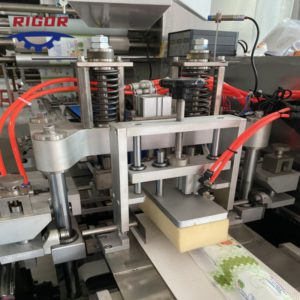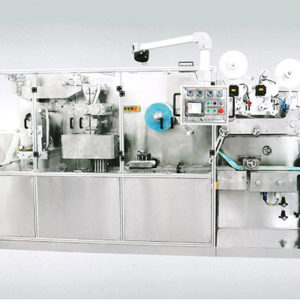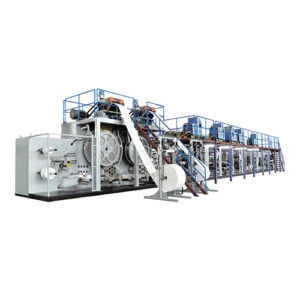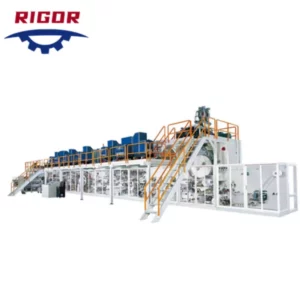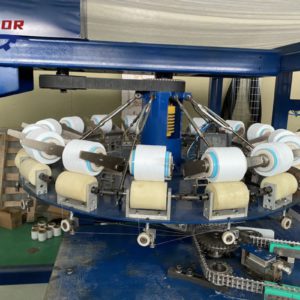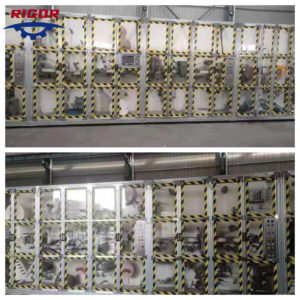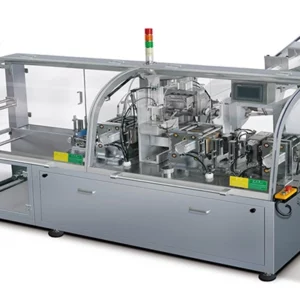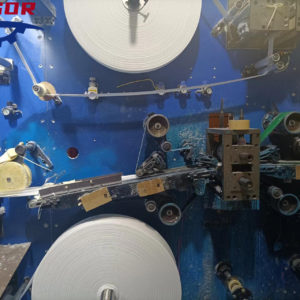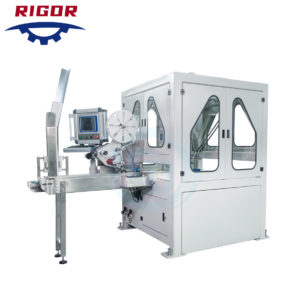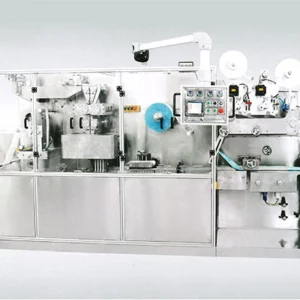Designing a factory with a wet wipes machine requires careful planning to ensure optimal efficiency, safety, and productivity. Here are some key parameters to consider when designing a factory with a wet wipes machine:
- Layout: The layout of the factory should be designed to accommodate the wet wipes machine and ensure a smooth flow of materials and personnel. The machine should be positioned in a central location to allow for easy access and maintenance.
- Space requirements: The wet wipes machine will require a certain amount of floor space, depending on its size and capacity. The factory design should accommodate this space requirement, as well as additional space for raw material storage, finished product storage, and personnel workstations.
- Electrical requirements: The wet wipes machine will require a certain amount of power to operate, and the factory design should include adequate electrical infrastructure to support the machine’s needs. This includes power supply, electrical outlets, and grounding.
- Ventilation: The wet wipes machine will release fumes and heat during operation, and the factory design should include adequate ventilation to maintain a safe and comfortable working environment.
- Material handling: The factory design should include a material handling system to transport raw materials and finished products to and from the wet wipes machine. This includes conveyors, carts, and other handling equipment.
- Safety measures: The factory design should include appropriate safety measures to protect personnel and equipment. This includes fire suppression systems, emergency exits, and personal protective equipment.
- Environmental considerations: The factory design should consider environmental factors such as noise levels, air quality, and waste disposal to minimize the impact of the factory on the surrounding community.
Overall, designing a factory with a wet wipes machine requires a comprehensive approach that considers all aspects of the production process. By carefully planning the layout, space requirements, electrical infrastructure, ventilation, material handling, safety measures, and environmental considerations, manufacturers can create an efficient and safe production environment that maximizes productivity and ensures the production of high-quality wet wipes.
What is a wet wipes machine
A wet wipes machine is a type of machine used to produce wet wipes, which are disposable cloths that are moistened with a cleaning solution. Wet wipes machines are used in a variety of industries, including personal care, household cleaning, and industrial applications.
A wet wipes machine typically consists of several components, including a roll of non-woven fabric, a liquid reservoir, and a cutting mechanism. The non-woven fabric is fed through the machine, where it is moistened with the cleaning solution from the liquid reservoir. The wet fabric is then cut into individual wipes of the desired size and shape.
There are different types of wet wipes machines available, ranging from small tabletop models for producing small quantities of wipes to large, fully automated machines capable of producing thousands of wipes per minute. Some machines are designed to produce specific types of wipes, such as baby wipes or industrial cleaning wipes, while others can produce a variety of wipe types.
Wet wipes machine type
There are several types of wet wipes machines available, each designed for different production capacities, product specifications, and industry needs. Here are some of the common types of wet wipes machines:
- Manual wet wipes machines: These machines are small and manually operated, typically used for producing small quantities of wipes. They are often used by small businesses or for research and development purposes.
- Semi-automatic wet wipes machines: These machines are partially automated and are used for medium-sized production runs. They require some manual labor for loading raw materials and unloading finished products, but the process is mostly automated.
- Fully automatic wet wipes machines: These machines are fully automated and are used for large-scale production runs. They are capable of producing thousands of wipes per minute and require minimal manual labor.
- Single sachet wet wipes machines: These machines are designed for producing individual sachets of wet wipes, often used in the personal care industry.
- Flow pack wet wipes machines: These machines are used for producing wet wipes in a continuous flow pack format, commonly used for household and industrial cleaning wipes.
- Multi-pack wet wipes machines: These machines are designed for producing wet wipes in bulk, packaged in a multi-pack format for retail sale.
- Customized wet wipes machines: Some wet wipes machines are designed and customized to meet specific production needs and product specifications, such as the size, shape, and type of material used.
Wet wipes machine markting
Marketing a wet wipes machine requires a targeted approach to reach potential customers in the personal care, household cleaning, and industrial industries. Here are some marketing strategies that can be effective:
- Identify the target audience: The first step in marketing a wet wipes machine is to identify the target audience. This may include manufacturers, distributors, or retailers in the personal care, household cleaning, or industrial industries.
- Showcase the features and benefits: Highlight the features and benefits of the wet wipes machine, such as its speed, accuracy, and reliability. Emphasize the convenience and efficiency of the machine in producing high-quality wipes.
- Demonstrate the machine: Demonstrate the wet wipes machine in action to showcase its capabilities and build confidence in potential customers. This can be done through product demos, video demonstrations, or webinars.
- Create marketing materials: Develop marketing materials such as brochures, videos, and social media content that showcase the wet wipes machine and its benefits.
- Attend trade shows and exhibitions: Attend industry trade shows and exhibitions to showcase the wet wipes machine and connect with potential customers. This can also provide an opportunity to learn about industry trends and competitor products.
- Provide excellent customer service: Provide excellent customer service to build trust and maintain strong relationships with customers. This includes providing support and training for the wet wipes machine and addressing any issues promptly.
wet wipes machine metiral
The materials used in wet wipes machines depend on the type of machine and the specific needs of the industry. Here are some of the common materials used in wet wipes machines:
- Non-woven fabric: This is the main material used in wet wipes production. Non-woven fabric is made from fibers that are bonded together without weaving, creating a soft, strong material that is perfect for wet wipes.
- Cleaning solution: A cleaning solution is used to moisten the non-woven fabric and provide cleaning properties to the wipes. The cleaning solution can be water-based or oil-based, depending on the specific needs of the product.
- Reservoir tanks: Wet wipes machines require a reservoir tank to hold the cleaning solution. The tank can be made of stainless steel or plastic, depending on the machine’s capacity and the industry needs.
- Cutting blades: Cutting blades are used to cut the non-woven fabric into the desired shape and size of the wet wipes. The blades can be made of stainless steel or other durable materials.
- Conveyor belts: Conveyor belts are used to transport the non-woven fabric through the machine and to the cutting blades. The belts can be made of rubber or other durable materials.
- Control panels: Control panels are used to operate the wet wipes machine and monitor its performance. The panels can be made of plastic or other durable materials.
How to manufacture wet wipes with wet wipes machine
Manufacturing wet wipes with a wet wipes machine involves automating the process and can greatly increase productivity and efficiency. Here are the general steps involved in manufacturing wet wipes using a wet wipes machine:
- Preparing the cleaning solution: The first step is to prepare the cleaning solution according to the desired formula. The solution is typically mixed in a large tank or vessel and is then pumped to the machine.
- Feeding the non-woven fabric: The non-woven fabric is fed from a roll into the wet wipes machine. The machine automatically cuts the fabric to the desired length and width.
- Moistening the fabric: The machine then applies the cleaning solution to the non-woven fabric using a series of rollers. The fabric is typically moisturized with a predetermined amount of solution to ensure consistent quality.
- Folding the wet wipes: The wet wipes machine then folds the non-woven fabric into the desired shape and size. The machine can fold the wipes into a variety of shapes and sizes, depending on the requirements of the product.
- Cutting the wet wipes: Once the wet wipes are folded, the machine then cuts them to the desired length using a high-speed cutting mechanism.
- Packaging the wet wipes: The wet wipes are then packaged into individual packets using a packaging machine. The packets are typically sealed to ensure that the wipes remain moist until they are used.
- Quality control: Throughout the manufacturing process, quality control measures are taken to ensure that the wet wipes are of high quality and meet the required specifications. This includes testing the cleaning solution, monitoring the size and shape of the wipes, and checking the packaging process.
